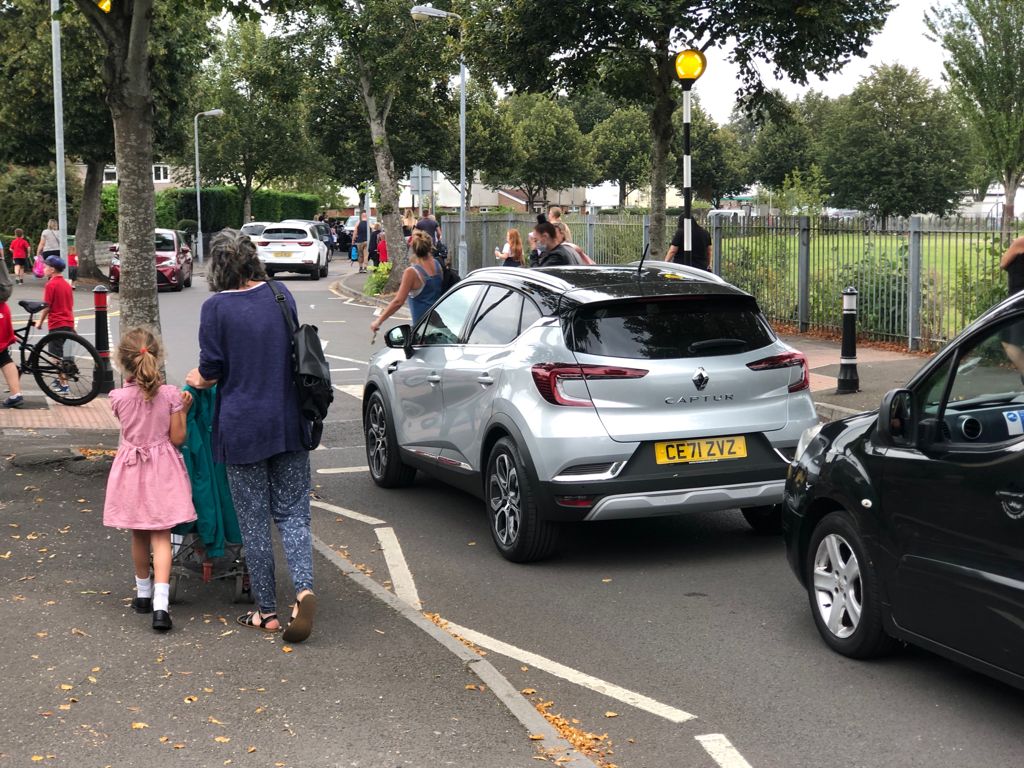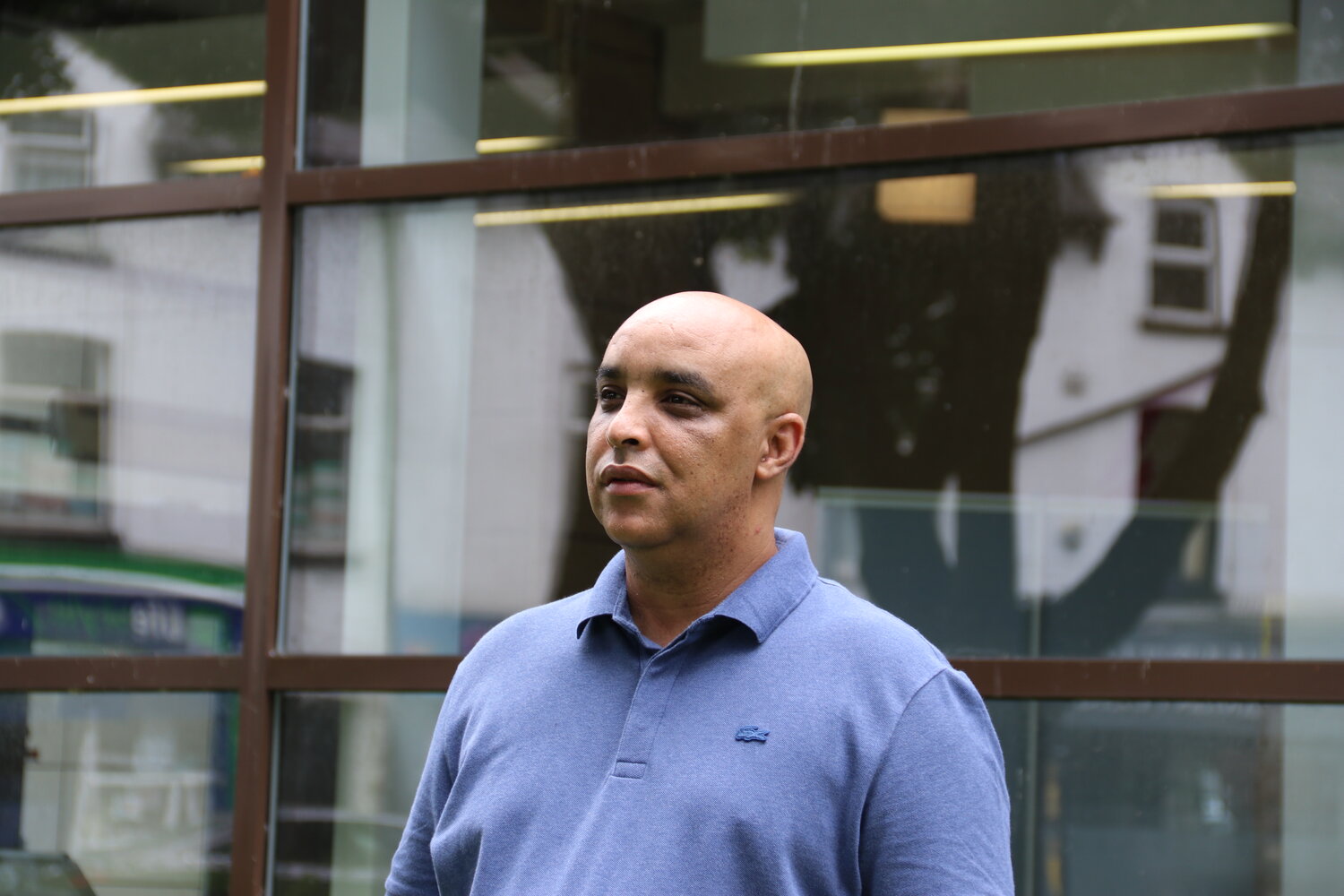
Parents Fear “Killer” Air Pollution At Cardiff Schools Is Being Ignored By Authorities
• Parents in Cardiff have signed an open letter demanding real-time air quality monitors to be rolled out at all schools in the city
• Cardiff has the fourth-worse air pollution levels in the UK, and Coryton Primary School, where parents have previously campaigned for a real-time air quality monitor, is located near one of the biggest roundabouts in the UK
• Poor air quality is linked to a plethora of health issues, and in 2013 it caused the death of nine-year-old Ella Kissi-Debrah in London
Image: Parents walking their children to school next to polluting traffic, courtesy of Alice Macintosh
Parents across Cardiff have come together to demand better air quality monitoring in the city’s schools, with parents from 19 schools and counting signing an open letter calling for real time air quality monitors to be installed at all schools across Cardiff, to enable residents “to understand the sources of air pollution properly and address them effectively”.
A 2019 University of Birmingham study found that air quality in Cardiff is worse than in London, with Cardiff ranked the fourth-worst for air pollution in the UK. The open letter signed by Cardiff parents and residents argues that “air quality is a real danger not currently being addressed” by Welsh Government and Cardiff council.
The open letter follows a similar petition that was signed by over 600 parents and residents associated with Coryton Primary School and the surrounding area earlier this year. Coryton Primary School is located just 0.3 miles from Coryton Roundabout, which is known to be one of the largest roundabouts in the UK, and parents are worried about resulting pollution levels and the potential impact on their children’s health.
The recent petition by parents and locals demands that the council install a real time air quality monitor at Coryton primary school so the risks of pollution can be more easily assessed, which they say would enable schools to work together with the council to address the issue, should pollution levels be indicated as dangerous.
Cardiff Council told voice.wales that a further ‘real-time, indicative, automatic analyser’ will be installed “close to Coryton Primary School” to “monitor for particulate matter (PM10 and PM2.5) and NO2”, and that “the data will be publically available”.
However, it is not yet clear where in relation to the school the analyser will be, and when it will be installed. Parent groups associated with the school are campaigning for real time air quality monitors to be rolled out at all schools in the city “as soon as possible” and say that they “cannot wait any longer whilst lives are at risk.”
Google map showing the proximity of the school to one of the UK’s biggest roundabouts
The health dangers of air pollution have been brought to the fore since the death of Ella Kissi-Debrah in London in 2013. Last year, a coroner ruled that the nine-year-old’s death was caused by acute respiratory failure, severe asthma and air pollution exposure.
Ella’s mother, Rosamund Kissi-Debrah, a former teacher, campaigned for years to have her daughter’s death examined by a second coroner, who eventually determined that the child was exposed to nitrogen dioxide and particulate matter (PM) pollution in excess of World Health Organization guidelines, with the principal source of this being traffic emissions.
Cardiff is one of 28 UK cities that have been identified as having air pollution issues, and Ella’s death has sparked fears that children in schools near busy roads in Wales could also be at the same risk.
“Without knowing where the danger is we are taking big gambles with our health and especially the health of children, unborn children and the elderly,” states the open letter from Cardiff parents. “In the two years before [Ella Kissi-Debrah’s] death no doctor or other professional informed Ella and her family that air pollution could have been a factor in Ella’s asthma; they were not aware of the dangers.”
Public Health Wales estimates that in the Cardiff and Vale Health board area, there is the equivalent of over 220 deaths attributed to Nitrogen dioxide (NO2 ) pollution each year among people aged 30 and over, with many more suffering ill health as a consequence of poor air quality. In Wales as a whole, air pollution is thought to contribute to 1,400 deaths a year.
Long-term effects of air pollution include increased rates of lung disease and cardiovascular diseases, cancer, and an associated risk of type 2 diabetes. Air pollution poses an even greater risk to children, as their airways are smaller and still developing. They also breathe more rapidly than adults, making them more vulnerable to pollutant exposure. The British Lung Foundation says that children exposed to air pollution for long periods could experience lung-related issues or cancer in the future, coughing, wheezing, pneumonia, and asthma. For children already suffering from asthma, air pollution will make their symptoms all the more acute.
Road transport is responsible for around 80% of the NO2 measured at the roadside, with Particulate Matter (PM) also a major concern. ‘PM’ refers to small particles of pollution in the air, with the primary transport-related source being vehicle exhausts, particularly diesel engines, as well as dust from brakes and tyre wear in all vehicle types, including electric vehicles.
“Air pollution is a silent killer,” says Michelle Gough, a Coryton Resident. “We want to ensure clean, safe air for our children and all members of our communities.”
The open letter states that air quality monitors would allow parents, locals and health and environment professionals to “understand the sources of air pollution properly and address them effectively, while seeing immediately which mitigating schemes are having an impact and which ones are not effective.”
According to Cardiff Council, they take parents’ concerns over air quality near schools “very seriously.” There are 136 diffusion tubes currently installed in Cardiff, and these assess the levels of NO2 in the air. The results of these NO2 diffusion tubes are collected manually and determined in a laboratory, and the council told voice.wales that plans are in place for these details to be uploaded to the council’s Clean Air Plan webpages.
However, while Nitrogen Dioxide (NO2) diffuser tubes have been installed near some schools, parents and residents are calling for air quality monitors to be provided at all Cardiff schools, and they stress that the current NO2 diffusers fall short in their ability to measure particulates and are not located near every school in Cardiff.
“Diffusion tubes are not real time monitors,” adds Alice Macintosh, a parent of children at Coryton Primary School. “They only monitor NO2 and the data is not available to the public; we need real time air quality monitors that also monitor particulates, and we need that data to be available to the community.”
There are some automated air-quality stations in Cardiff but these are installed on Fredrick Street; Richards Terrace, Castle Street and in Lakeside. This data is automatically uploaded online. There are also seven ‘real time indicative automatic analysers’ monitoring a range of gases every 15 minutes, but five of these are located in the city centre, one in the Air Quality Management Area in Llandaff and one on Lansdowne Road, Canton.
There have been concerns previously over the threat of air pollution to Cariff schools, after lobby group Client Earth claimed that nine schools were likely to have air pollution issues. The nine primary and secondary schools were situated in the wards of Gabalfa, Roath, Adamsdown, Butetown, Cathays and Llanedeyrn.
However, according to Cardiff Council, “[Client Earth’s] assumptions were based on modelled data, rather than actual monitored data…The results of the Council’s monitoring indicated that none of the schools had elevated NO2 concentrations, with each school having NO2 levels significantly below the air quality objective for NO2.”
Cardiff Council was previously awarded £21m by the Welsh Government to tackle air pollution issues. In June 2019, the Council submitted its final plan for a package of measures which includes a bus retrofitting programme to lower emissions, taxi mitigation measures, city centre transport improvements and an ‘active travel’ package to promote and facilitate walking and cycling in the city.
Alice says that while these measures are encouraging, they don’t go far enough. “They [the council] talk about wanting people to change their behaviour in regards to car use and seeing that as the way forward,” she says. “Behavioural science tells us that the best way to get behaviour change is for there to be tangible evidence that the change in behaviour has an effect on something. So having the monitors in place would mean people could physically see the difference that is made to the quality of air when cars are used and when they are not.”
She also adds that the active travel plans are “somewhat lacking in terms of being safe for children” due to there being a lack of cycle path near her children’s school, and the route to the primary school being next to a busy road.
“Although measures are being looked at and developed it is not enough and not fast enough,” Alice argues.
The plan to reopen Castle Street in Cardiff city centre for private cars has also attracted criticism from environmental campaigners. Since last November, the road has been opened for taxis and buses only, with the pavement widened for pedestrians and an integrated cycle lane added.
However, roadworks are scheduled to begin to accommodate an additional lane of traffic after a public consultation, which received 6,227 responses, showed 54% wanted the road reopened to private cars.
With private cars back on Castle Street, the council is forecasting nitrogen dioxide rates on the road to increase by 40%. With the road only open for buses and taxis, council officers said NO2 rates had increased on nearby residential streets as a result of the closure, but opponents say the plans will lead to greater levels of overall traffic.
The reopening of the road means the pavement on the south side of Castle Street will also be made narrower, which again seems to contradict the council’s plans for Active Travel and easier walking and cycling in the city.
The climate crisis has also sharpened the focus on environmental issues such as air pollution. In April 2019 Wales’ then-Environment Minister Lesley Griffiths declared a climate emergency, yet the Welsh Government has since been criticised for a lack of action, and a recent report from the Climate Change Committee (CCC) said Wales’ current plans to protect people, infrastructure and wildlife “will not be sufficient”.


